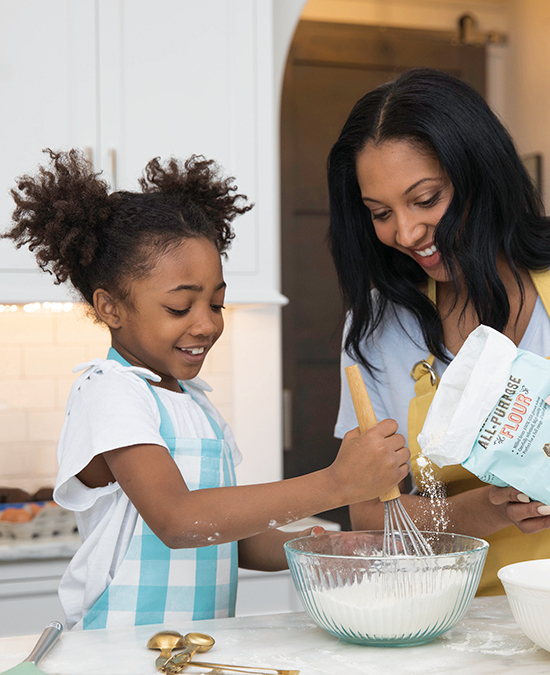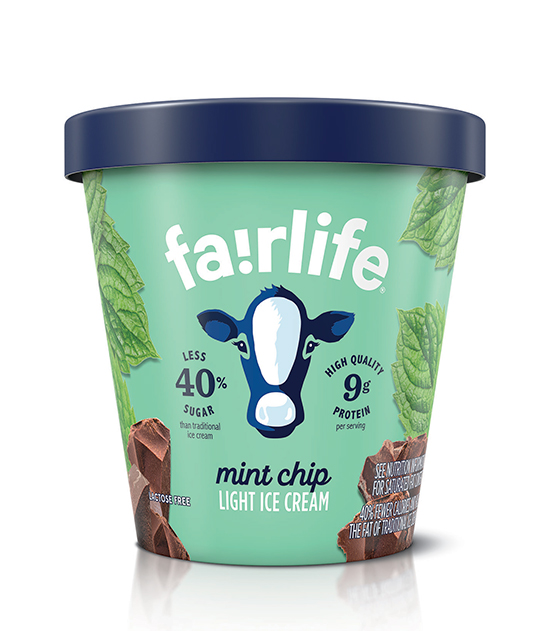HEALTHY LIVING
Easy ways to enjoy life’s everyday moments

(Family Features) For many people across the country, carving out time from busy schedules to spend with loved ones can be difficult. However, when opportunities arise to experience bonding activities together, the results can be fond memories and a deeper sense of security.
“Many families, mine included, usually put a lot of energy into planning fun events and special trips to create memories,” said Amanda Mushro, TLC lifestyle expert and fairlife ambassador. “These get-togethers help us cope with challenges and remember to make the most of each day. This year, while disappointing, has revived our chances to slow down a little and savor the little moments that happen at home every day.”

Build Strong Bonds
Life gets busy, and in the shuffle it’s easy to overlook the importance of quality time with your friends, family, and significant others. Commit to regularly (and safely) spending one-on-one time with each loved one as a special treat you can all cherish. Even if it’s just snuggling and watching a favorite show together, crafting or doing an activity you both enjoy, try making an effort to slow down and strengthen your bonds.
Head Outdoors
Leave the technology behind and go for a walk or a bike ride together once or twice a week. It’s a ritual you can look forward to while taking advantage of the time together and the chance to burn some energy. You can take outdoor appreciation even further by planning camping trips to enjoy the joys of wildlife through activities like bird watching, fishing or impromptu scavenger hunts.
Make Meals a Family Affair
Not only does getting the whole family involved make the preparation faster, it’s a chance to squeeze in some time and maybe even some learning and sharing. Kids can help with measuring and other age-appropriate tasks, and the casual setting is a good environment to get kids talking about what’s on their minds.
If evenings are too rushed to make an all-hands approach practical, instead try carving out some time on the weekends or once a month for a few hours of baking up batches of a favorite treat. You can also find new and fun family-friendly recipes. Even if the recipe doesn’t turn out well, the time spent doing it together is a treat on its own.
Enjoy Tasty Treats Together
There’s nothing quite like a bowl of ice cream to light up a face and mood so break out the scooper and make some sweet memories. Set up your next sundae bar with a tasty option like fairlife Light Ice Cream, a delicious, lactose-free frozen dessert with a strong nutrition profile compared to traditional ice cream. It comes in seven flavors, so there is something for everyone.
Avoid Life’s Stressors
Outside influences can have a major impact on your mood and ability to enjoy your time at home. Try turning off your phone notifications for a few hours of uninterrupted home time. If clutter is creating havoc, look for ways to improve your home’s organization and get everyone in the house to pitch in to keep things in place.
Schedule Weekly Fun Nights
Designate a night each week to have fun together playing games, watching movies or dancing. Pull out the board and card games or get some fresh air with yard games like croquet or bag toss. Sign up for a virtual cooking fitness class. When it comes to movies, enjoy old favorites together or introduce kids to beloved classics from the ’80s and ’90s and incorporate fun traditions with snacks and special treats.

Rethink Dessert for Better-for-You Moments
Special moments and gatherings often revolve around food. With some simple (and tasty) adjustments, you can still savor every moment, including dessert, without overindulging.
Choose a light(er) frozen delight. A cool scoop (or two) of dessert is a perfect cap for all kinds of cuisines and making smart choices can help manage the calorie load. One example is fairlife Light Ice Cream, delicious frozen desserts expertly crafted with ultra-filtered milk and natural flavors for a lactose-free product with a rich, creamy texture. In comparison to traditional ice cream, it has less sugar, fat and calories. Additionally, depending on which of the seven flavors you choose, it contains 8 or 9 grams of high-quality protein.
Make fruit the star. Fresh berries or seasonal fruit like peaches with fairlife Vanilla Light Ice Cream are a refreshing and more nutritious option than a rich cake or pie filled with added sugars. Or try dipping fruit like grapes or strawberries in chocolate for bite-sized treats.
Serve perfect portions. Occasionally treating yourself is actually a good way to help keep your healthy lifestyle on track. It minimizes the sense of deprivation that can lead to overeating. The trick is to manage your portions. Miniature cheesecakes or tarts are enjoyable ways to treat yourself with a sweet ending to the event. Or try making your own ice cream sandwiches using reduced or sugar-free cookies and light ice cream for the filling. Each pint of fairlife Light Ice Cream has 3 servings per container.
Photo courtesy of Getty Images (Couple playing Chess)
SOURCE:
fairlife
HEALTHY LIVING
5 habits to help maintain immune health

(Family Features) Cold and flu season is here. The best way to battle cold and flu season is to prevent coming down with anything at all. While it’s impossible to stay entirely safe from germs, sniffles and coughs, there are a few healthy habits you can incorporate for extra protection this year.
Along with the guidance you receive from your health care provider, consider these dietary and lifestyle recommendations to support your immune system naturally.
Commit to a Healthier Diet: Essential for optimizing your immune system, eating a healthy diet consisting of more foods like fruits, vegetables, nuts, seeds, legumes and whole grains is recommended by experts. These foods contain beneficial plant compounds linked to health benefits in humans. Case in point: fresh grapes.
Natural grape compounds, including antioxidants and other polyphenols, may help protect the health and function of cells. At the most basic level, healthy cells are the foundation of good health.
Making simple swaps such as choosing fresh California grapes instead of processed snacks or adding grapes into favorite recipes for a healthy boost are tasty ways to add these beneficial compounds.
Studies suggest some grape compounds may positively influence immune function, including resveratrol and certain flavonoids. Additional studies show adding heart-healthy grapes to your daily diet can help support brain, colon and skin health. Grapes are also a good source of vitamin K, which may help support lung health. Incorporate the health benefits of grapes into your diet with an easy, convenient recipe like Grape and Brussels Sprout Slaw, perfect for eating on its own or pairing with a favorite protein such as grilled chicken breast.
Prioritize Basic Hygiene: Preventive practices can help you avoid germs, protecting yourself and others at the same time. Frequently wash your hands using soap and water, limit contact with others who may be sick and cover your nose and mouth with a tissue or elbow while coughing or sneezing.
Stay Active: Cold and flu season lines up with brisk temperatures, often making it more difficult to get outside for exercise. Find an activity you enjoy like moderate-intensity walking, jogging, biking or playing an aerobic sport. The “Journal of Sport and Health Science” reports exercise can help improve immune response and reduce inflammation, making it a key way to prepare your body to fight back.
Hydrate, Hydrate, Hydrate: Staying hydrated helps your immune system by keeping the body’s defenses functioning properly. In addition to drinking water, you can increase hydration by eating foods with high water content like grapes, which contain about 82% water.
Manage Stress: You can help control stress – which has a negative impact on overall health and wellness – in a number of ways. Practice deep breathing or meditation, engage in activities and hobbies that bring joy and develop nighttime habits that promote good sleep. If snacking in the evening, choose foods such as grapes that are a natural source of melatonin, a compound which helps regulate sleep cycles. Talk with someone you trust, like a friend, family member or mental health professional, to help relieve stress.
Visit GrapesFromCalifornia.com to find more ways to support your immune health.

Grape and Brussels Sprout Slaw
Servings: 6
- 1 bag (12 ounces) shredded Brussels sprouts
- 2/3 cup finely shredded red cabbage
- 2 cups red Grapes from California, halved lengthwise
- 1/2 cup finely diced red onion
- 3 scallions, trimmed and thinly sliced
- 2 tablespoons rice vinegar
- 1 1/2 tablespoons honey
- 1 teaspoon fresh lemon or lime juice
- 1 teaspoon low-sodium soy sauce
- 2 tablespoons olive oil
- 1 tablespoon toasted (dark) sesame oil
- freshly ground black pepper, to taste
- 3 tablespoons toasted sesame seeds
- In large mixing bowl, combine shredded sprouts, cabbage, grapes, onion and scallions.
- In small bowl, whisk vinegar, honey, lemon or lime juice and soy sauce. Drizzle in olive and sesame oils while whisking. Toss well with slaw mixture. Chill 45 minutes to incorporate flavors. Season with pepper and sprinkle sesame seeds on top.
Nutritional information per serving: 170 calories; 4 g protein; 22 g carbohydrates; 9 g fat (48% calories from fat); 1.5 g saturated fat (8% calories from saturated fat); 0 mg cholesterol; 60 mg sodium; 4 g fiber.
HEALTHY LIVING
How to discuss vaccination with family, friends

(Family Features) During the fall and winter months, respiratory infections such as flu, COVID-19 and RSV can surge. People who are vaccinated lower their risk of getting seriously ill and needing medical care if they get infected. About 70% of adults in the United States said they probably or definitely will get a flu shot, and more than 50% said they probably or definitely will get an updated COVID-19 vaccine. While many people are ready to get this season’s vaccines, others might still have questions.
“It is normal for people to have questions about vaccines,” said Peter Marks, MD, PhD, director of the U.S. Food and Drug Administration’s Center for Biologics Evaluation and Research, which oversees and reviews vaccine clinical trials. “It’s important for everyone to know that all vaccines go through extensive testing before they are approved and that following approval, they are carefully monitored to identify any safety concerns so that they can be addressed quickly. Hundreds of thousands of volunteers have taken part in respiratory vaccine trials. The results tell us that these vaccines are safe and effective in preventing severe disease caused by flu, COVID-19 and RSV.”
Here are some ways to talk about the importance of this season’s vaccines with a family member or friend who is unsure about getting vaccinated.
Hear them out.When talking about vaccination, it’s important to make others feel heard. There are many reasons why people may have questions and concerns about vaccines or even the health care system in general. Listen to their thinking and try not to judge. They want to know their thoughts and feelings matter.
Focus on the facts. Instead of calling out vaccine myths, focus on vaccine truths. Concentrating on myths can cause them to become the topic of your conversation. Instead, speak about the benefits of vaccines. For instance, you can mention vaccines cut your risk of being hospitalized for flu or COVID-19 by about half.
Ask if they need help getting vaccinated. Sometimes, people just need some help to find, schedule and get a vaccination. You can help them find a vaccine location at Vaccines.gov. They may also need help finding child care or figuring out whether they can take time off from work. Offering a ride or accompanying them can also be helpful, especially if the closest vaccination site is far away. If English is not their primary language, offer to help them schedule the appointment and arrange for a medical translator if needed. When it’s easier to get vaccinated, people are more likely to take this important step to help protect their health.
Having open, honest and supportive conversations about vaccines with family members and friends can make all the difference. For more information, visit cdc.gov/RiskLessDoMoreor talk to your doctor.
Flu, COVID-19 and RSV Vaccines Help People Risk Less Severe Illness and Do More of What They Enjoy
This season’s vaccines are now available. Everyone 6 months and older should get an updated flu and COVID-19 vaccine. Everyone ages 75 and older, or 60 and older with certain health conditions such as such as heart disease, lung disease, obesity or diabetes, should get an RSV vaccine if they have not been vaccinated for RSV before.
For certain people, the risk of serious respiratory illness remains high. These include adults ages 65 and older, residents of long-term care facilities, pregnant people, people with certain health conditions and those living in rural areas. People in some racial and ethnic groups, including people who are Black or Hispanic, are also at higher risk. People who are not up to date on flu, COVID-19 and RSV vaccines can reduce their risk by getting their 2024-25 vaccines as soon as they can.
To get started, visit Vaccines.gov.
Photos courtesy of Shutterstock
SOURCE:
United States Department of Health and Human Services
HEALTHY LIVING
Smart starts for a healthy heart

Improve hydration, skip added sugars with better-for-you beverages
(Family Features) How you start your morning can impact the rest of your day. If you’re looking to incorporate healthier choices into your morning routine, try a concept known as “habit stacking.” Building tiny, healthier habits into routines you already have, like enjoying a morning beverage or breakfast before you check your email instead of jumping right into the day’s tasks, can make it easier to stick to a new habit when it’s built into an existing routine.
If you already enjoy the routine of breakfast to start the day, consider swapping sugary drinks for beverages without added sugars like unsweetened green or black tea. When incorporated as part of an overall healthy diet, unsweetened tea can help support heart health.
If you need help getting started, Lipton, a proud national sponsor of the American Heart Association’s Life is Why campaign, created these easy-to-make, better-for-you tea recipes.
A small handful of ingredients makes a big splash in Green Tea Berry Banana Smoothies, ideal for an on-the-go breakfast. For a little refreshment any time of day, simple Sparkling Green Tea Cranberry Spritzers offer a solution with 0 grams of added sugars while non-alcoholic Green Tea Mojito Mocktails provide natural sweetness with 100% fruit juice.
Choosing beverages with no added sugars can contribute to a healthy heart, according to the American Heart Association, making these recipes perfect for daily habit stacking. Water is needed to keep your body running at its best, and because unsweetened tea is 99.5 % water, it provides a delicious way to help hydrate.
Discover more ways to improve daily routines at Heart.org/eatsmart.

Green Tea Berry Banana Smoothies
Recipe courtesy of the American Heart Association
Servings: 4 (1 1/2 cups per serving)
- 3 cups water
- 8 single-serving green tea bags
- 16 ounces frozen mixed berries (about 3 cups)
- 2 medium bananas, peeled, cut in half and frozen
- 1 cup fat-free plain Greek yogurt
- 2 teaspoons fresh-grated peeled gingerroot (optional)
- 2 teaspoons vanilla extract (optional)
- 2 teaspoons chia or flax seeds (optional)
- In small saucepan over high heat, bring water to boil. Remove pan from heat. Submerge tea bags. Steep 4 minutes. Discard tea bags. Let tea mixture cool 30 minutes. Pour into pitcher. Refrigerate 2 hours, or until chilled.
- In food processor or blender, process tea, berries, bananas and yogurt until smooth. Add gingerroot and vanilla, if desired, and process until smooth. Pour into four glasses. Sprinkle with chia seeds, if desired.
Nutritional information per serving (without optional ingredients): 136 calories; 1 g total fat (0 g saturated fat, trans fat, polyunsaturated fat and monounsaturated fat); 3 mg cholesterol; 23 mg sodium; 29 g carbohydrates; 5 g fiber; 18 g total sugars (0 g added sugars); 8 g protein.

Green Tea Mojito Mocktails
Recipe courtesy of the American Heart Association
Servings: 4 (1 1/2 cups per serving)
- 4 cups water
- 4 single-serving green tea bags
- 32-40 sprigs fresh mint, plus additional for garnish, divided
- 2 cups ice cubes
- 1 cup 100% white grape juice
- 1/2 cup fresh lime juice (about 4 medium limes)
- 1 medium lime, cut into four wedges or lime zest twists (optional)
- In small saucepan over high heat, bring water to boil. Remove pan from heat. Submerge tea bags. Steep 4 minutes. Discard tea bags. Let tea mixture cool 30 minutes. Pour into pitcher. Refrigerate 2 hours, or until chilled.
- At serving time, add mint leaves to four glasses. Using muddler or wooden spoon, mash mint leaves several times to release juices. Don’t mash into pulp. Add ice.
- Stir white grape juice and lime juice into tea mixture. Pour into glasses. Garnish each with lime wedge and mint leaf.
Tip: To get more juice from citrus, before slicing, microwave fruit on high 30 seconds, or until warm. When cool enough to handle, use citrus reamer or handheld juice press to juice citrus.
Nutritional information per serving: 45 calories; 0 g total fat (0 g saturated fat, trans fat, polyunsaturated fat and monounsaturated fat); 0 mg cholesterol; 7 mg sodium; 13 g carbohydrates; 0 g fiber; 10 g total sugars (0 g added sugars); 1 g protein.

Sparkling Green Tea Cranberry Spritzers
Recipe courtesy of the American Heart Association
Servings: 4 (1 1/2 cups per serving)
- 4 cups water
- 4 single-serving green tea bags
- 1 cup 100% cranberry juice or 100% cranberry-pomegranate juice
- 2 cups ice cubes
- 1/2 cup seltzer (flavored or plain) or low-sodium club soda, chilled
- 4 orange slices or lime wedges (optional)
- In small saucepan over high heat, bring water to boil. Remove pan from heat. Submerge tea bags. Steep 4 minutes. Discard tea bags. Let tea mixture cool 30 minutes. Pour into pitcher. Stir in cranberry juice. Refrigerate 2 hours, or until chilled.
- At serving time, put ice cubes in four glasses. Pour tea mixture into glasses. Top each serving with seltzer. Garnish with orange slices.
Tip: To create cranberry-flavored ice cubes, fill ice cube tray with 100% cranberry juice and freeze.
Nutritional information per serving: 32 calories: 0 g total fat (0 g saturated fat, trans fat, polyunsaturated fat and monounsaturated fat); 0 mg cholesterol; 4 mg sodium; 8 mg carbohydrates; 0 g fiber; 8 g total sugars (0 g added sugars); 1 g protein.
SOURCE:
American Heart Association
-

 NEWS2 years ago
NEWS2 years ago2 hurt, 1 jailed after shooting incident north of Nocona
-

 NEWS1 year ago
NEWS1 year agoSuspect indicted, jailed in Tia Hutson murder
-

 NEWS2 years ago
NEWS2 years agoSO investigating possible murder/suicide
-

 NEWS2 years ago
NEWS2 years agoWreck takes the life of BHS teen, 16
-

 NEWS1 year ago
NEWS1 year agoMurder unsolved – 1 year later Tia Hutson’s family angry, frustrated with no arrest
-

 NEWS2 years ago
NEWS2 years agoSheriff’s office called out to infant’s death
-

 NEWS2 years ago
NEWS2 years agoBowie Police face three-hour standoff after possible domestic fight
-

 NEWS2 years ago
NEWS2 years agoDriver stopped by a man running into the street, robbed at knifepoint





